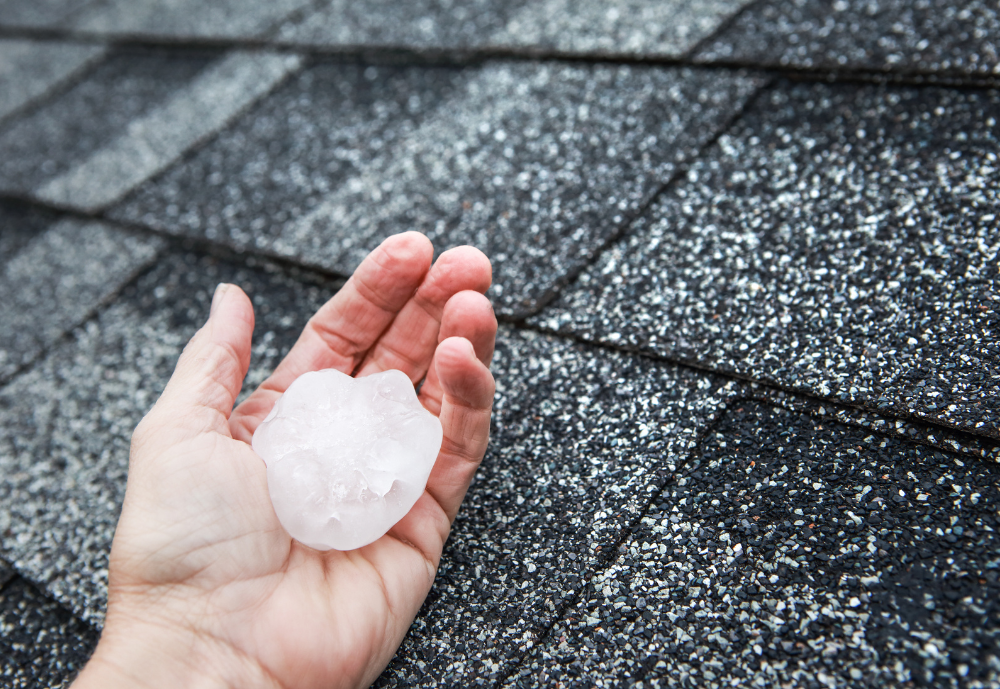As summer temperatures rise, so does the chance of severe weather, including hailstorms.
While many of us might find storm season thrilling (storm-watching is a beloved Midwest pastime, after all), the damage it can cause to homes and commercial buildings is much less exciting. Not all thunderstorms produce hail, but when they do, that hail can pose a significant threat to both residential and commercial properties, causing substantial damage to roofs, siding, gutters, and more.
In this blog, we’ll focus on how hail can damage your roof, as well as the importance of taking preventive measures to protect your residential or commercial property from hail damage.
How Hail Can Damage Your Roof
Hail typically varies in size from tiny pellets to golf-ball-sized spheres, but can sometimes get even larger (check out this news report on baseball-sized hail!). When these icy projectiles hit your roof, they can cause damage ranging from small dents to cracks and punctures, depending on their size and how fast they fall.
Residential Roofs
Your roof is your home’s first line of defense. And a roof in good repair can withstand a fair amount of abuse from severe weather, keeping your home and belongings safe and dry.
But your roof isn’t impervious to damage from summer storms.
Flash floods, high winds, and hail can cause damage to your roof that isn’t always immediately apparent, but that gradually weakens its structure. When hail hits your roof, it has the potential to create small indentations that can lead to cracks, punctures, or granulated shingles. This damage compromises your roof’s protective barrier, leading to leaks and interior water damage.
Hail can also damage your gutters and downspouts. When your gutter system is damaged, it isn’t able to properly move water away from your roof, potentially causing pooling that can lead to leaks.
Commercial Roofs
The roof of your commercial building is equally vulnerable. Commercial roofing materials like metal, single-ply membranes (such as EPDM, TPO, and PVC), and built-up roofing can sustain damage from hail, including:
- Dents
- Cracks
- Punctures
- Tears
- Displaced aggregate
In addition, flat roofs face a unique challenge during summer storms: Due to their design, water doesn’t run off as efficiently as on pitched roofs, increasing the risk of water pooling and seeping through openings. If your building has a flat roof, pay particular attention to this issue, watching for pooling water after storms.
5 Ways To Prevent Roof Hail Damage
Given the potential for extensive hail damage it’s vital to take proactive measures to protect your roof, including the following.
1. Practice Good Storm Preparedness
Keep an eye on the weather forecast and take necessary precautions before a potential storm hits, such as securing loose objects to avoid blowing debris hitting your roof during high winds.
In addition, keep trees and shrubs around your property trimmed back, as hail can cause limbs and even whole trees to fall on your roof. After a storm, check your roof for debris and remove it promptly to keep tree limbs, trash, and other debris from accumulating.
Clean out gutters and drains regularly as well to ensure they function properly during storms.
2. Choose Weather-Resistant Roofing Materials
Investing in durable roofing materials that are rated for hail resistance, high winds, and UV radiation can significantly reduce the damage caused by severe storms. Choose materials with a proven track record of withstanding hail, such as impact-resistant single-ply membranes or metal roofing.
In addition, consider installing elements like hail guards and gutter screens to help shield your roof from the impact of hail damage.
3. Keep Your Roof Maintained
A well-maintained roof is better equipped to withstand severe weather conditions.
Visually inspect your roof regularly, and stay up-to-date on its maintenance. After every severe summer storm, assess any damage from the ground. If you notice damage, have it repaired promptly to protect it from further storm damage and prevent it from leading to further issues like water damage and mold growth.
4. Schedule Routine Professional Roof Inspections
Schedule regular roof inspections with a professional to identify and address any vulnerabilities or existing damage.
A pro is trained to safely inspect your roof. They can notice even the subtlest signs of damage and provide a detailed evaluation, ensuring you don’t overlook minor issues that could escalate into bigger ones. Plus, a professional roof inspection can offer invaluable insights into your roof’s overall health.
After an inspection, your roofer will give you their recommendations for repair. At this point it’s important to act quickly. Unrepaired roofing damage will only get worse over time.
5. Make Sure Your Roof is Covered by Insurance
Ensure your property is adequately insured for potential hail damage, and that you are familiar with the coverage and claims process so you’re prepared when it comes time to file a claim.
Even if your roof is brand new, you may not be able to rely on your roof’s warranty to cover repairs for hail damage. Hail damage isn’t typically included in warranties for roofing materials (in fact, many manufacturers specifically exclude hail damage from their warranty coverage). Read the fine print in your warranty, and make sure you have enough insurance in place to cover damage from hail.
Hoyt Is Here To Help With Summer Storm Damage
Severe summer storms can unleash a torrent of destruction on residential and commercial roofs alike. Understanding the potential impact hail can have on your roof and taking the necessary precautions is essential to protect your investment and safeguard your home or commercial property from the fury of summer storms.
Has your roof suffered hail damage? Hoyt Exteriorscan provide a roof inspection and handle any repair or replacement you may need for your home or commercial property. Give us a call today at 651-212-4965 to get on our schedule.

